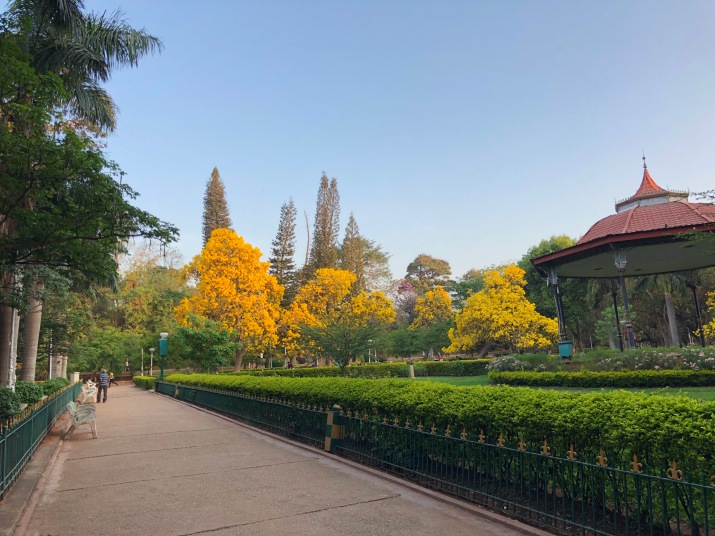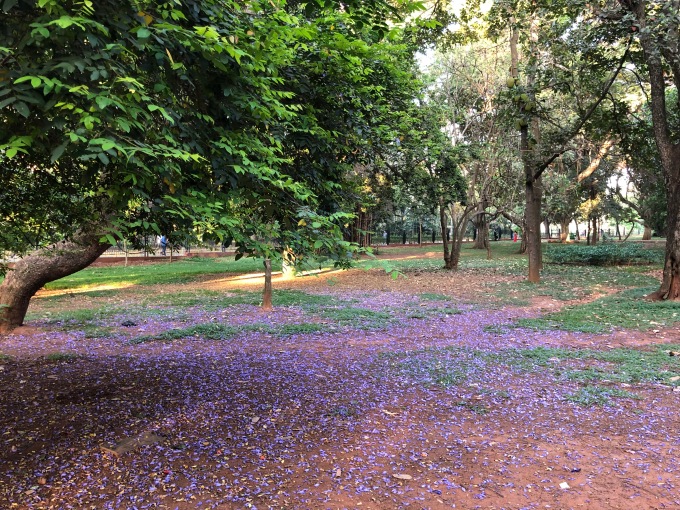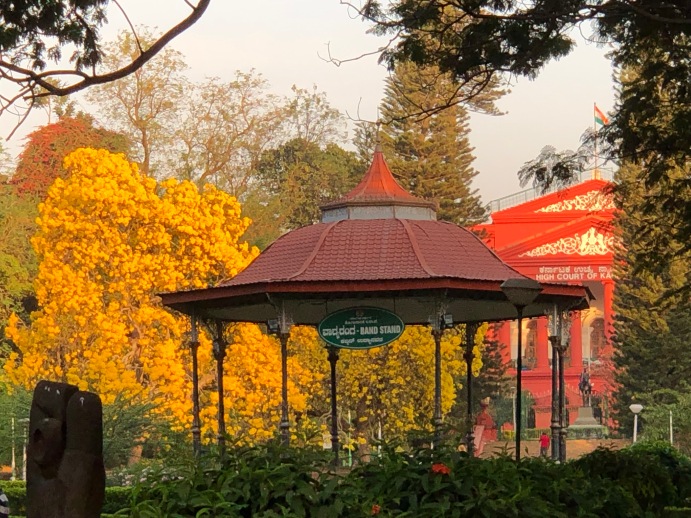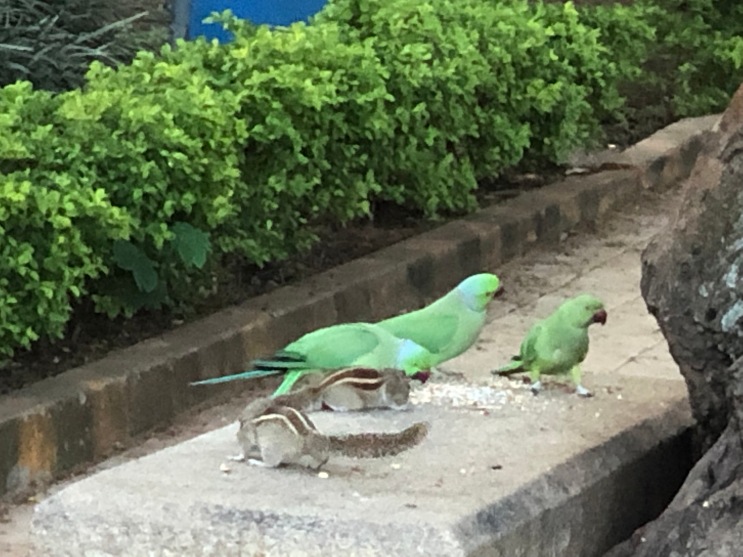
We’ve been driving out to some of those pleasant places situated roughly between 60 and 100 km from Bangalore on some Saturdays ever since the lockdown ended last year. Driving down the smooth highways is as much of a pleasure as reaching the destination, something unthinkable ten years ago.
We start out around 6:00 a.m. and stop for breakfast on the highway at a place that has outdoor seating, and the waiters are masked. We keep our masks on, except when we are actually eating. Most often, no other table is occupied, so we are social distanced anyway.
A plate of piping hot idli-sambar, or a masala dosa, with a tumbler of coffee, and we are on our way to a memorable visit to some nice dreamscape. The Deccan plateau is dotted with hills strewn with massive boulders, that make for a climb that is neither easy nor hard, but just right to give us a great workout and a sense of achievement. The view from the top is enough to make one send up a prayer of thanks for being a Bangalorean! And the cool breeze up there? Heavenly!
There are no crowds at any of them, especially as we arrive before 8:00 in the morning. And we are back home by late afternoon, before Bangalore’s awful traffic starts jamming up the roads, after a scrumptious lunch at a restaurant on the highway. We normally make a game of spotting a good eatery and predicting the quality of the fare on offer before pulling over. We have never been disappointed!
Here are some snapshots.
Thottikallu falls: Bangalore Urban district, 35 km south of Bangalore
This was our first outing. We made the mistake of starting out late in the morning, and the place was crowded. Entry to the falls was restricted so we walked along the river and peeked at the falls from a distance. Actually, just being out in the open after months of lockdown was itself exhilarating enough for nothing else to matter!
*******
Shivanasamudra falls: Mandya district, 133 km southwest of Bangalore
Again, beautiful but crowded place, but large enough to keep a safe distance from others who, like us, were reveling in their new freedom. Shivanasamudra is like Nandi Hills – all of us Bangaloreans treat it like our backyard and drive up whenever we feel like running away from Bangalore’s noise and air pollution.
*******
Antargange: Kolar district, 64 km east of Bangalore
We climbed up many flights of steps that led to a small temple complex. Behind the temples was a trekking trail to reach the caves that Antargange is famous for. The climb involved feeling for hand- and footholds to clamber up and around rocks. It was between easy and moderate, very satisfying.
We didn’t go into the caves to avoid getting into unventilated spaces. Local people selling water, bananas and cucumbers along the way told us there were no corona cases there, but we kept our masks on and kept our distance.
*******
Kailasagiri: Chikkaballapura district, 77 km northeast of Bangalore
We reached Kailasagiri at 8:30 a.m. We were the only people there! We thought it might be closed, as it was a public holiday for Sankranthi. We looked it up online and found it would open at half past ten.
As we sat on a low wall not sure what to do, we saw motorbikes coming out of a lane every few minutes. So we went to check out what was up the lane and ended up walking uphill for 3.5 km.
The trail opened on to a flat wide space where there was a small Anjaneya temple that housed a stone slab with a 1000-year-old carving of Anjaneya. The temple archak told us it had been dug out from under a huge anthill and consecrated. A larger temple was under construction.
From this point one could climb up the rocky hill to a fort at the top but we decided to do that another time, as the trek under an overcast sky had been fulfilling enough for one day.
*******
Haddinakallu: Tumkur district, 104 km west of Bangalore
We parked at the base of the hill and learned from locals that we had to leave our shoes in the car and go up the hill barefoot as they regarded the entire hill as holy. There was a tiny shrine right there near where we parked, and one more a little way up, apart from the temple right at the top.
Feeling the ancient rough granite underfoot was nice, actually, despite the occasional pointy little stones I sometimes stepped on. There were no trees, no shade at all, so it was a tiring climb to the top. The view was as spectacular as expected. We could see our parked car so far below that it seemed like we would never be able to get back to it again!
Coming down, the granite underfoot was scorching hot and we tippy-toed to the car as fast as we could. It was a very hot day. Even the cold water we had carried in thermoses didn’t slake our thirst. We stopped at a sugarcane juice gaadi a few km down the road and I felt this was perhaps what amrit, the nectar of the gods, tasted like!
*******
Lepakshi: Anantpur district, Andhra Pradesh, 124 km north of Bangalore
Lepakshi is just across the Karnataka-AP border. There’s a temple complex built by the Vijayanagar kings in the 15th century. It is like Hampi on a much smaller scale and has the same super-peaceful Hampi vibe.
Lepakshi is where the bird Jatayu fell when Ravana attacked him in the Ramayana. Lord Rama tried to revive him saying “Get up, bird”, which is “Lepakshi” in Telugu. There’s a huge sculpture of Jatayu and a nicely maintained park around it.
On this trip there was no trekking or rock-climbing. Just walking through the ancient temple complex, then around the Jatayu Park and the nearby Nandi Park was nice. We came across unexpected little pockets of beauty: a small lotus pond, bougainvillea in every colour along the path, clever work by ancient stone masons where they had moulded the slabs to follow the contours of the hill on which the temple was built – interesting little things like that.
And there was a Hangyo ice cream kiosk selling the creamiest kulfi, most welcome on a hot Andhra day!
Achalubetta: Bangalore Rural district, 73 km southwest of Bangalore

Acchalu is a tiny hamlet, a cluster of 15-20 little houses. We asked a couple of women how to get to the top of the hill behind their village and they said, “follow the electricity lines”. Perfect directions!
We climbed up nearly to the top without meeting a single soul. It was unseasonably warm, so we decided to turn back a kilometer or so shy of the hilltop.
When we passed a flat-ish part of the trail I picked up a long straight stick and tried a ‘javelin throw’, wholly inspired by Neeraj’s Olympic gold medal! As someone who used to be a javelin thrower in high school I was thrilled to watch it trace a beautiful arc and land with its point hitting the ground. And when my kid shouted, “Ma, you threw so well!” I felt a surge of podium-level joy!
When we came down to the village the women we had met earlier asked if we had enjoyed the climb. They smiled broadly when I gave them a thumbs-up and said I’d love to buy a house in Acchalu and live there.
*******
Makalidurga: Bangalore Rural district, 58 km north of Bangalore
We asked the young couple next door if they would like to join us with their toddler. They were thrilled at the prospect of an outing where the little one could expend some of her boundless energy.
Luckily, the first part of the trek was a walking path, minimally inclined, not strenuous at all. It was fun watching the kid exclaim over everything she had been denied in her corona-controlled young life. She kept picking up mud and letting it slip out between her fingers, enjoying its texture. She ran up and down the trekking trail, then settled down on a large rock and began to seriously build cairns!
We turned back when we reached the part where we would have to negotiate rocky paths to climb uphill.
A railway track passed through Makalidurga and a pretty red train, a long one, went by, much to the little girl’s surprise and delight.
*******
Avani: Kolar district, 94 km east of Bangalore
The high point of the drive to Avani was the flame-of-the-forest trees in bloom in the near distance. We got down to take a closer look at one particularly beautiful one.
The legend of the Sita temple in Avani goes back to the days of the Ramayana. It is said to be the birthplace of Lord Rama’s sons Lava and Kusha. The many temples in the complex, as I understand it, were built in the 10th century by a Kannadiga dynasty called Nolamba that I had not heard of before.
As we were there for trekking I didn’t really take in enough of the history and architecture, something that I intend to do another time. The climb was worth it, though – good exercise, good view from the hilltop.
*******
Madhugiri: Tumkur district, 105 km northwest of Bangalore
The fort at the top of the hill was closed because of COVID. We strolled around parts of Madhugiri town near the fort and absorbed the town vibe, watching people go about their business. The feel of a town and city are so different, so it was a nice change from Bangalore.
When we came upon this crossroad a flurry of rapidly changing images rushed through my mind, of places I had been to as a child, villages I had passed through in more recent years, places I had seen in movies, scrambled with places I had imagined in History classes at school. There was a strange but pleasant sense of déjà vu.
*******
SRS Hills and Kootgal: Ramnagara district, 63 km southwest of Bangalore
We set out at 6 o’clock in the morning and stopped for a breakfast of thatte idli that’s famous around Bidadi. At Ramanagara we got off the highway and drove down a State road flanked by massive ancient trees. I took the wheel on this beautiful smooth winding road that took us through many, many little villages with names that seem to encapsulate a story.
Gollachennayyana doddi. Maybe this land was once owned by a cowherd/shepherd (golla) called Chennayya?
Petekurubanahalli. Was there someone from the Kuruba community who moved to the big city (pete) and prospered and was thereafter referred to as Pete-Kuruba, and then others started referring to his village by the name of its successful son?

We reached SRS hills at about quarter past eight. Like Haddinakallu, we had to climb barefoot but it was an easy climb up roughly hewn steps to the Siddeshwara temple at the top of the hill. And the trail was completely in the shade of a metal awning that extended all the way from the bottom to the top. The view was typical Ramnagara, comfortingly familiar.
As this had been an easy climb we drove another 20 km to Kootgal. In the eighties, a trekker friend and I had gone as guides with my younger sister and her friends to Thimmappanabetta near Kootgal on a night trek. We had had to put off the trek because local people told us there were bears about at night. So we had slept in the bus stand at Kootgal and walked to Thimmappanabetta in the morning.
It looked exactly the way it did then! I was glad to see the immutable Kootgal rocks standing stolidly in a world where everything changes too rapidly for my comfort. From one side we got an aerial view of the neat little village of Kootgal.
*******
Mandaragiri: Tumkur district, 62 km northwest of Bangalore
The Jain temple was closed due to COVID. We climbed to the top of a monolithic granite hill, an easy climb. We walked through the foliage and reached a lake where there were already a lot of people.
I saw a dog chase and catch a baby bird by its wing. The mother bird followed the dog, twittering anxiously. Without thinking, I chased the dog. The dog dropped the baby bird and dived into the undergrowth, and the baby bird flew away with its mother. Then the dog came out and hunted around for its prey and slunk away in disappointment . . . I was left with the unhappy feeling that I had intervened in something that wasn’t my business. Then I noticed that he had a collar . . .
*******
Avalabetta: Chikkaballapur district, 91 km north of Bangalore
We left home at 6:00 a.m. as usual and had breakfast on the way. Bright patches of flaming orange and yellow marigold fields flew past our windows every now and then, and we couldn’t resist pulling over once to admire them and take snaps.
At Avalabetta we parked the car in the area that has been recently cleared for parking cars and bikes because of it’s sudden popularity with trekkers. Then, on an impulse, we decided to stroll a little way down the narrow mud road leading to the next village. The surface was terrible but there was a rusty board saying the government planned to pave it . . . It really should get down to it asap. Villagers on motorbikes passed us every few minutes on our 2 km walk and it was obvious they were struggling to keep their balance, especially on the parts that were very much like scree, dangerously slippery.
There were little patches of wild flowers all along the edge, and tufts of lemon grass that had a definite citrus smell when I crushed a blade between my fingers.
After walking for 2 km we turned back and went to the beginning of the trail to climb the hill. It wasn’t very challenging as it was just a nicely paved road leading to the temples at the top. There was a Sunday crowd (that’s why we normally trek on Saturdays) so we kept our masks on and didn’t stay long.
At one point I stopped to ask a young couple coming down how much longer it would take to reach the top. It was a very short conversation (‘Where are you from?’ ‘Bangalore. And you?’ ‘Also Bangalore’) but the boy self-consciously inserted “we’re married.” I was astonished, but caught on fast enough to say, “Oh my, I’m not the moral police here!” They laughed loudly in relief but looked sheepish at the same time.
























































































































 Now something has to be done about the helmet-less little children who ride in front of the rider (as in picture above), or squeezed in between the rider and pillion-rider! And people who carry their helmets in their hands (as in pic).
Now something has to be done about the helmet-less little children who ride in front of the rider (as in picture above), or squeezed in between the rider and pillion-rider! And people who carry their helmets in their hands (as in pic). 

 Girls no longer seem to take the blame for ‘attracting attention.’ You hear of girls and their parents filing complaints at police stations without worrying about what their relatives and neighbours will think. It’s just an impression. Maybe I’m wrong. Maybe the press reports only on people who file cases. Perhaps the percentage of girls taking action has only increased a little, and maybe many still don’t file. Police records may not reflect reality.
Girls no longer seem to take the blame for ‘attracting attention.’ You hear of girls and their parents filing complaints at police stations without worrying about what their relatives and neighbours will think. It’s just an impression. Maybe I’m wrong. Maybe the press reports only on people who file cases. Perhaps the percentage of girls taking action has only increased a little, and maybe many still don’t file. Police records may not reflect reality.





